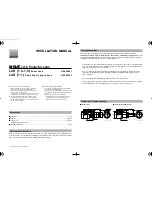
Radar based Blind Spot Information System
MBHL TypA Operating & Integration Manual
Remarks:
Certification Documentation
Revision:
2.1
Date:
12/12/2011
Page:
21 of 29
VALEO-RADAR SYSTEMS, INC.
Laiernstr. 12, D-74321 Bietigheim-Bissingen / Germany
+ 49 (+7142) 916 – 0
+ 49 (+7142) 916 – 4000
This document is the exclusive property of Valeo-Raytheon System, Inc.
It cannot be communicated or divulged to anybody without a previous written authorization.
4.1.2.5. Latency
The maximum time between an object of interest entering or exiting the alert zone
and the signalling of an alert within the BSD Sensor shall be defined between VRS
and OEM depending on the system architecture.
4.1.2.6. Maximum relative speed
Alerts shall be reported for object of interest relative speeds up to Vrmax defined
by OEM specifications. However, due to system latencies, for high relative speeds,
the difference between the time the vehicle enters the defined zone and the time
the alert indication is generated will make it appear as if there was a reduction in
the size of the alert zone.
4.1.2.7. Mutual interference
The BSD Sensor shall not interfere with other systems on the vehicle or other
vehicles. The same or similar BSD systems on other vehicles shall not interfere
with the proper reporting of alerts by the BSD Sensor.
4.1.2.9. False alert of an object of interest
A database needs to be created which documents the system performance for
each scenario defined by OEM. The performance in terms of missed and false
alerts depends on the environment.
4.1.3. Determine operating state function
VRS shall provide to OEM the BSD Sensor operating states and transitions. Each
sensor’s operating state is determined based on its own operating condition and
information received from the vehicle, including the other sensor.









































